Donauwelle Kuchen (Danube Wave Cake, also sometimes called Schneewittchenkuchen or Snow White Cake) is a classic German cake with layers of vanilla and chocolate cake, sour cherries, buttercream, and chocolate. It's as stunning as it is delicious!
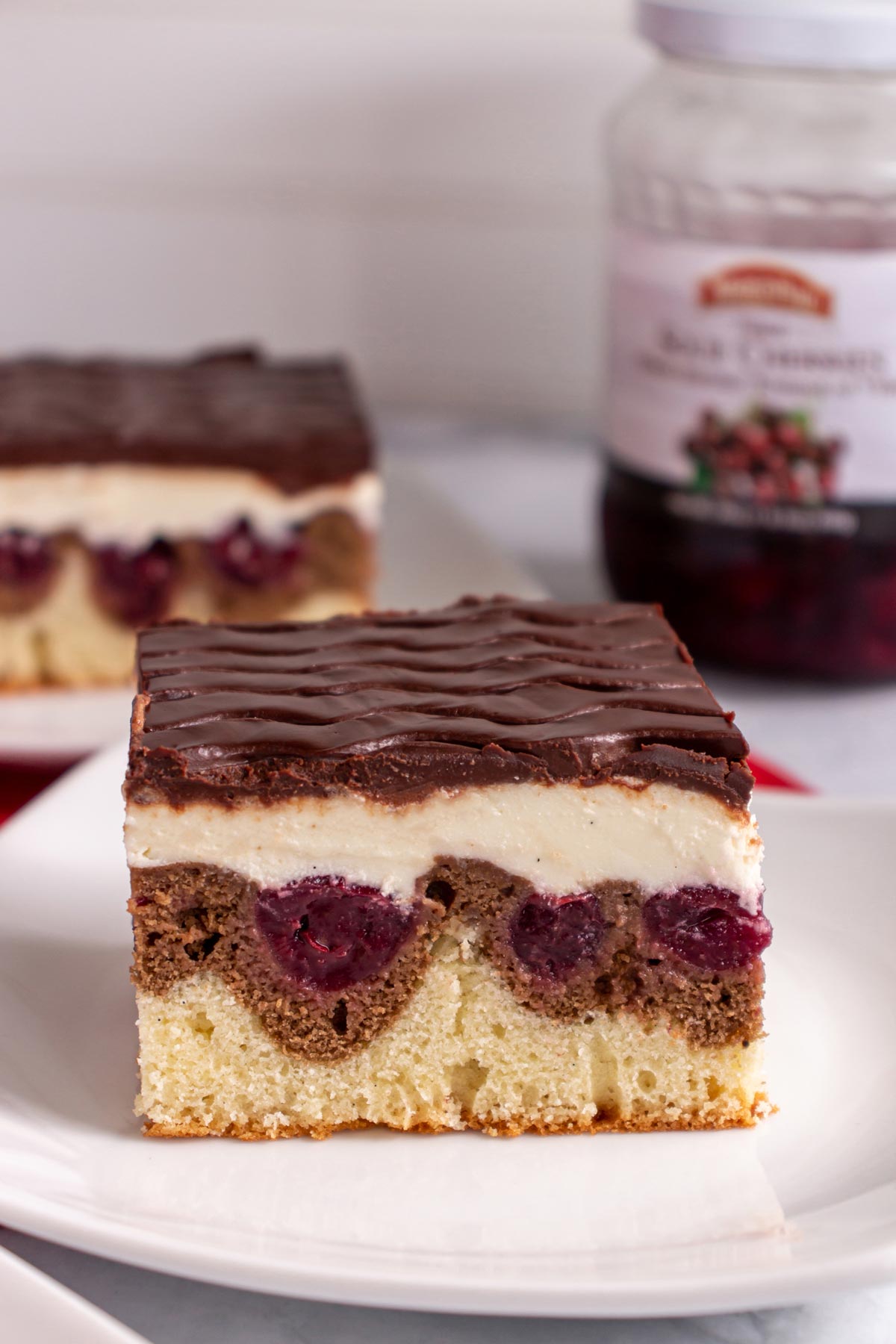
I was first introduced to Donauwelle cake via a store-bought frozen version sold at Aldi. After taking one bite I thought to myself, "I have to make this from scratch!" The homemade results are even better and I highly recommend making this gorgeous cake yourself for pretty much any cake-worthy occasion.
The word Donauwelle means "Danube wave" in German (with Donauwellen as the plural form). This traditional sheet cake is popular in both Germany and Austria. It gets its clever name from the appearance of a wave pattern in the cake itself, as well as in the chocolate layer on top.
This classic cake is also sometimes called Schneewittchenkuchen, meaning Snow White cake, because of its black, white, and red color scheme. These colors are representative of the character of Snow White in the Brothers Grimm's fairy tale.
There are 5 distinct layers in Donauwelle cake:
- Vanilla cake batter
- Chocolate cake batter
- Pitted sour cherries
- German buttercream
- Chocolate glaze
The cake itself is slightly dense and firm-crumbed but still quite moist. It’s offset by the juicy and tart cherries embedded within it. The buttercream is not too sweet, super creamy and light. Meanwhile, the ganache maintains the perfect set but silky texture as the final touch on this showstopper of a cake that really has it all.
German buttercream is basically light, fluffy, buttery vanilla pudding. Whipping butter and pastry cream (or vanilla pudding) together yields a mildly sweet vanilla-laced cream that tastes surprisingly light for the amount of butter it contains. It firms up quite a bit when chilled, resulting in crisp, smooth edges when you cut the cake.
Ingredient notes
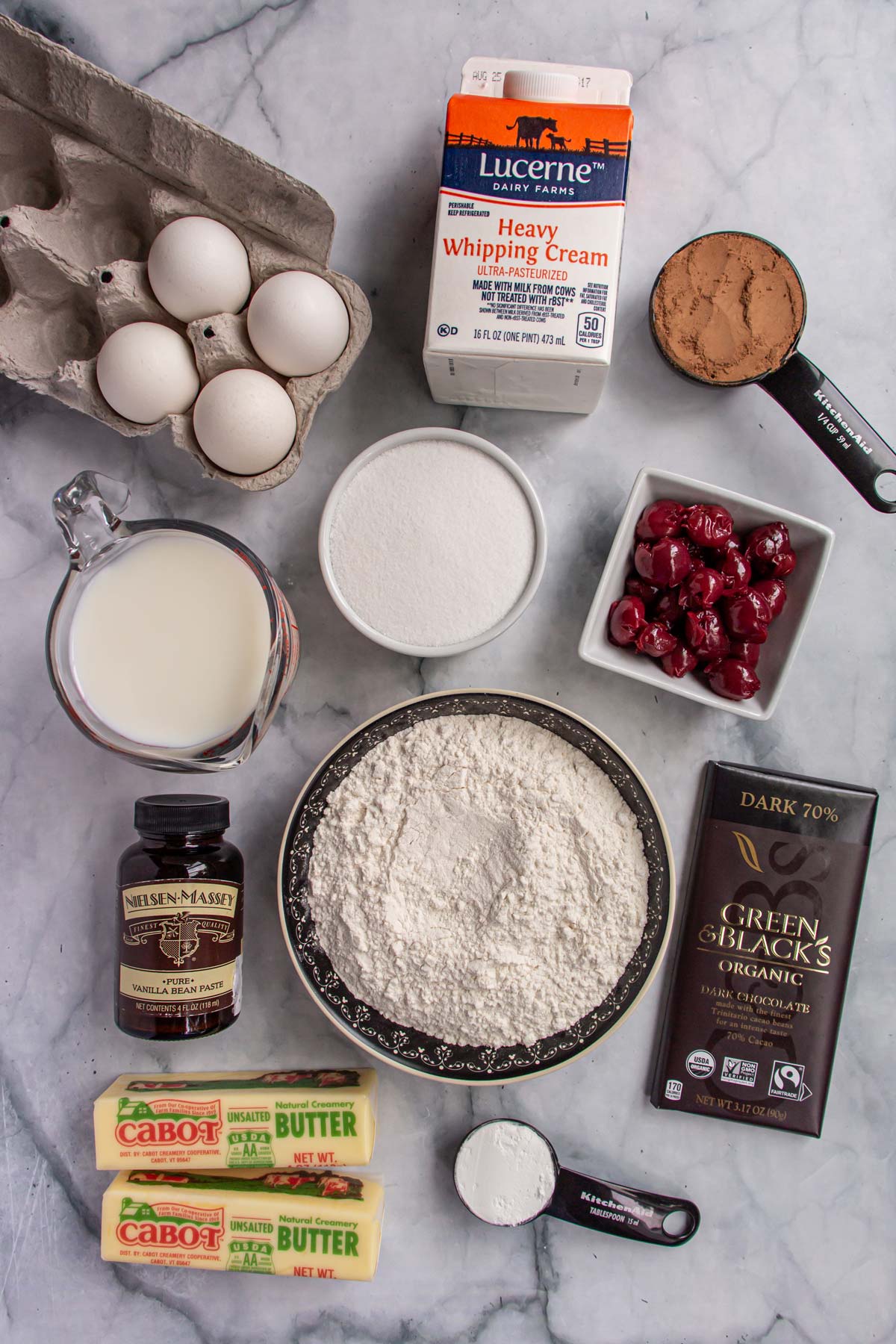
- Vanilla: Use pure vanilla extract or vanilla bean paste to flavor the cake and the buttercream. I love vanilla bean paste because it's easy, convenient, lasts longer in the pantry than fresh vanilla beans, and you still get the gorgeous specks of real vanilla bean throughout your creation!
- Chocolate: For the ganache, use chocolate with around 70% cacao for a good balance of sweet/bitter flavor. Ideally chop your own chocolate bar(s) instead of using chocolate chips. Chocolate chips contain stabilizers which prevent them from melting as smoothly as pure chocolate bars.
- Cherries: I did some research in the US market on the best canned or jarred pitted sour cherries to use for Donauwelle. I compared Oregon brand Red Tart Cherries in water and Marco Polo brand Pitted Sour Cherries packed in cherry juice. The Marco Polo brand was far and away the more appropriate variety of sour cherries that closely matches what you would find in Germany. They're darker purple and have a wonderful flavor which is perfect for this recipe! I get mine at Whole Foods and use the entire jar (drained) for this recipe. I have also since tried this recipe with a jar of Specially Selected Dark Morello Cherries from Aldi (same size jar as the Marco Polo) and they work perfectly. These cherries were perhaps even a bit more intact than the Marco Polo jar, which contained more broken cherry pieces. As a bonus, the ones from Aldi are actually from Germany! Aldi carries these jarred Morello cherries from time to time, but may not always have them year round, so stock up if you see them. Regardless of the brand you use, check the cherries to ensure there aren't any pits left in them. Do not use cherry pie filling or cherries packed in heavy syrup.
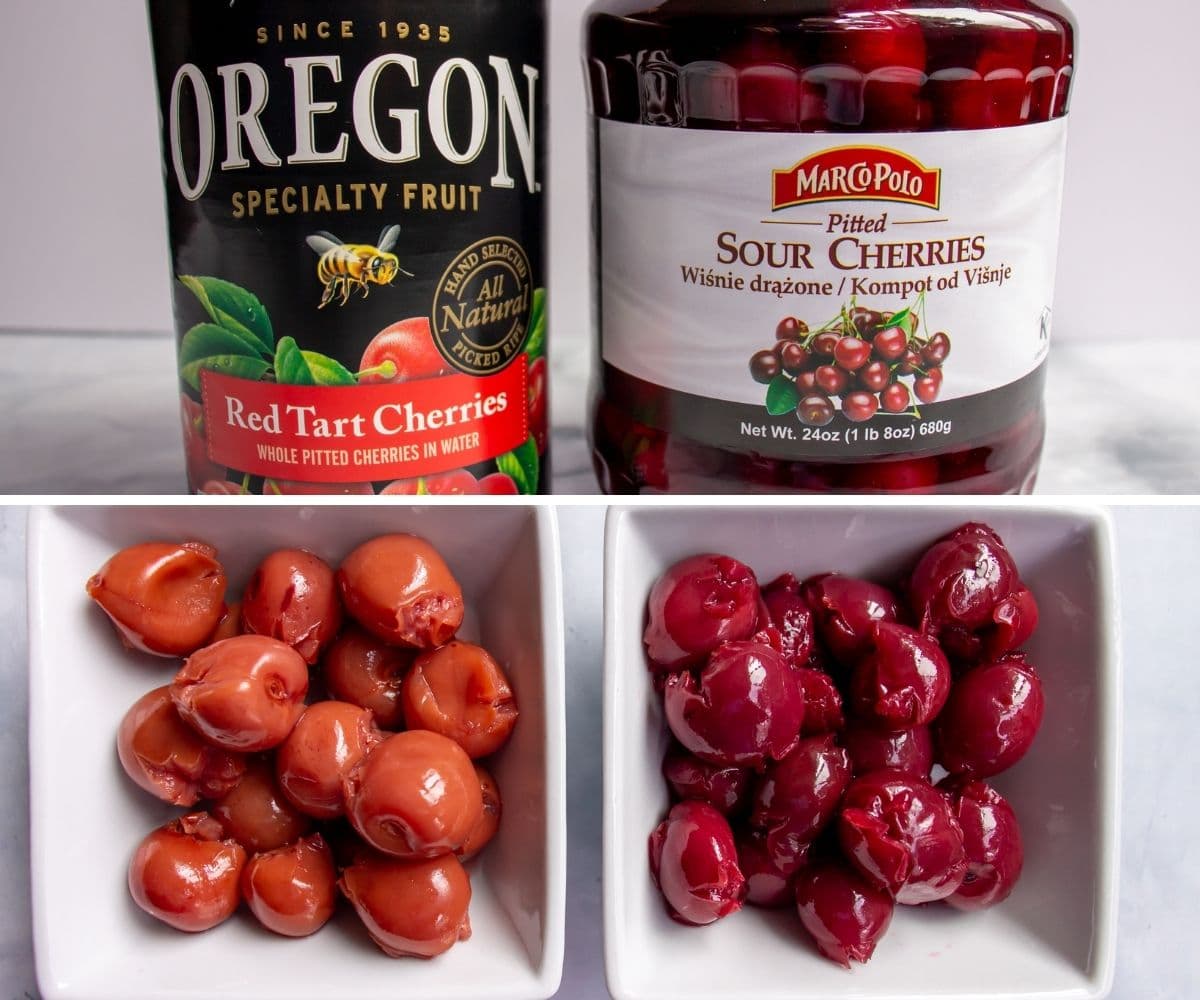
How to make the German buttercream
In a large saucepan or small pot beat the egg yolks together, then slowly add the milk beating until smooth. Add the sugar and cornstarch and whisk until smooth. Heat the pan over medium heat, whisking constantly until the mixture is very thick and easily coats the back of a spoon.
Remove from the heat, whisk in vanilla until smooth, then use a rubber spatula to scrape the pastry cream mixture into a bowl. It will cool faster if it’s spread out in a wider bowl or container. Press a piece of plastic wrap directly onto the surface of the custard so it doesn't form a skin. Cool it to room temperature.
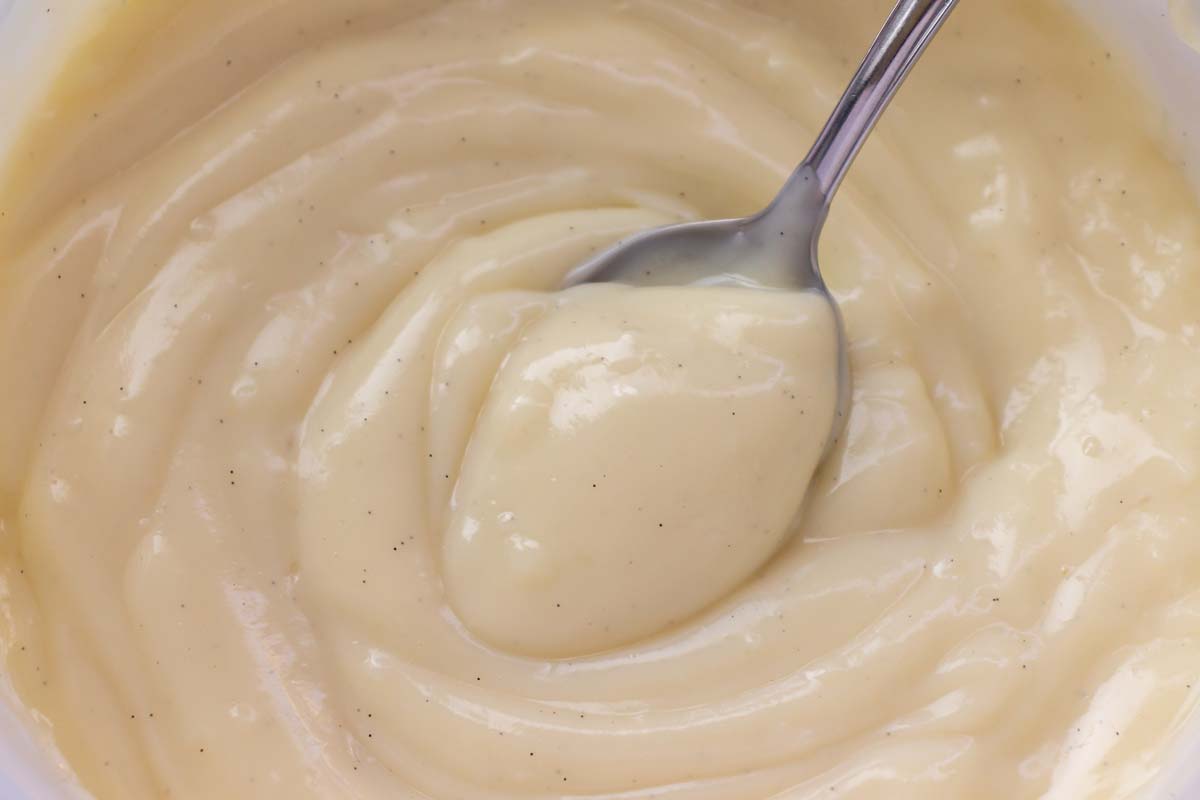
Note: The pastry cream and butter should both be at room temperature before proceeding with the next step. Cold pastry cream and room temp butter will not combine properly, and will yield a slightly curdled-looking mixture.
To finish the buttercream, add butter to the bowl of an electric mixer fitted with the whisk attachment and beat until very light and creamy. With the mixer running on medium speed, add the pastry cream a little at a time until completely combined. Scrape down the sides and then continue beating for another minute to ensure it’s smooth and creamy.
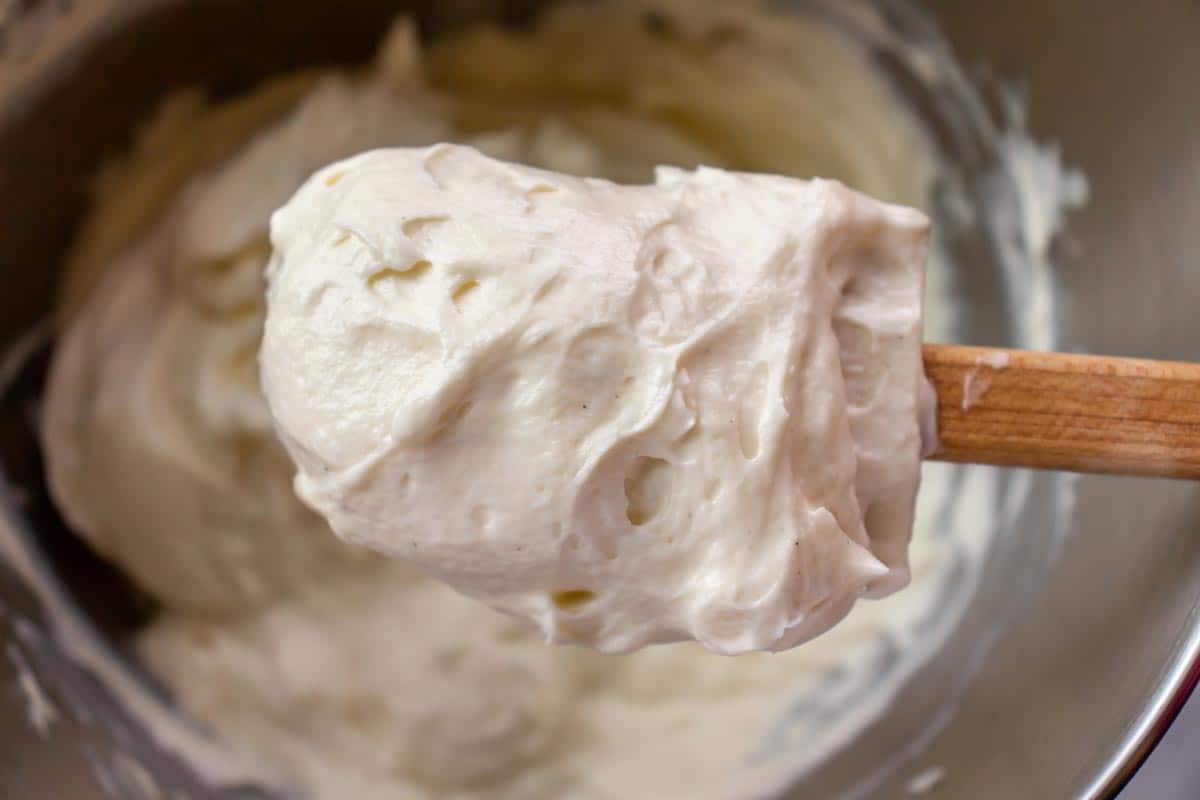
How to make the cake
Preheat the oven to 350°F / 180°C with the rack in the lower third of the oven. Line a 9-by-13-inch (24-by-32-cm) rectangular cake pan with parchment paper with some overhang around the sides to help you lift the cake out of the pan after assembling. Lightly grease the parchment.
Note: All your ingredients should be at room temperature for optimal results. Completely drain the sour cherries and set them on paper towels to absorb excess juices before using.
Combine the flour, baking powder, and salt in a mixing bowl and set aside.
Add butter and sugar to the bowl of an electric mixer fitted with the paddle attachment and beat on medium speed until light and fluffy. Add the eggs, one at a time, beating between additions until smooth. Scrape down the sides and beat in the vanilla. Finally, add the flour mixture in 2 additions and beat just until combined.
Evenly spread about ⅔ of the cake batter into the prepared pan.
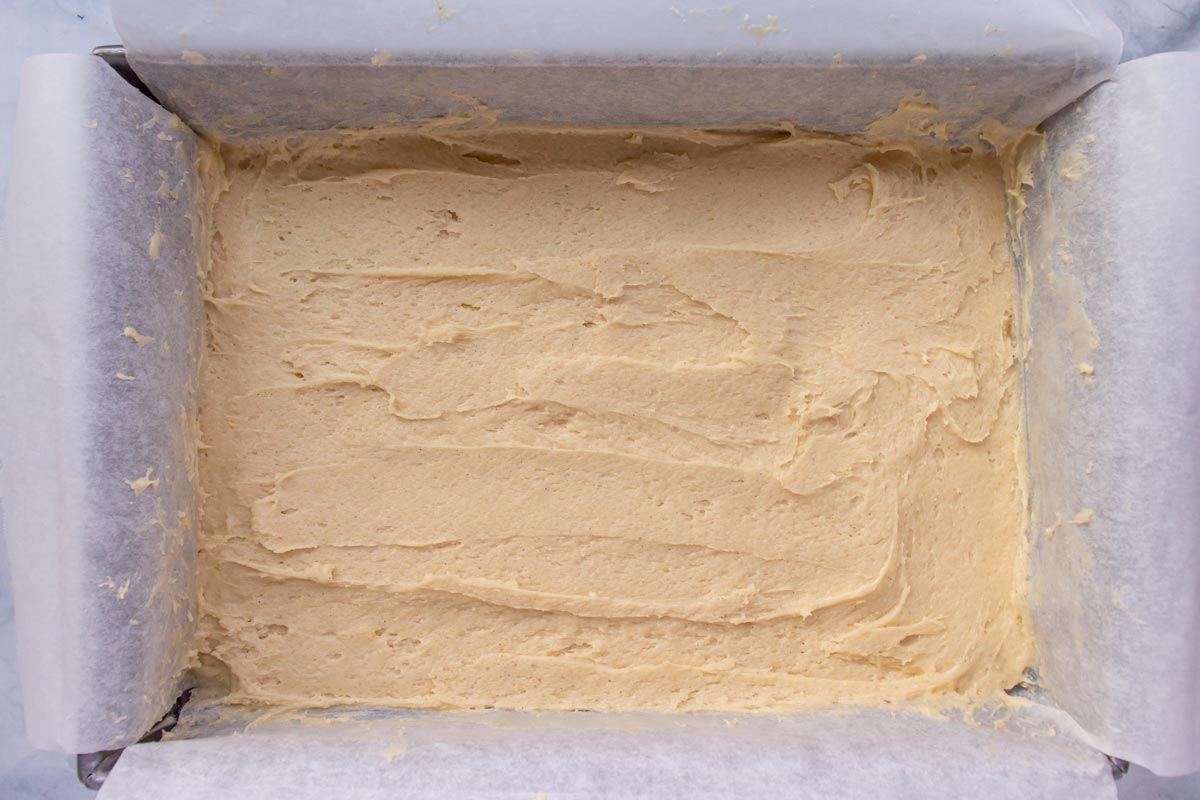
Sift the cocoa powder into the remaining batter and add the milk. Mix until just combined, then carefully spread it over the top of the light-colored batter.
The best way to do this is to dollop spoonfuls of chocolate batter over the vanilla layer and then carefully spread the batter until the chocolate layer is even (PHOTOS 1-2). Do not swirl the layers together!
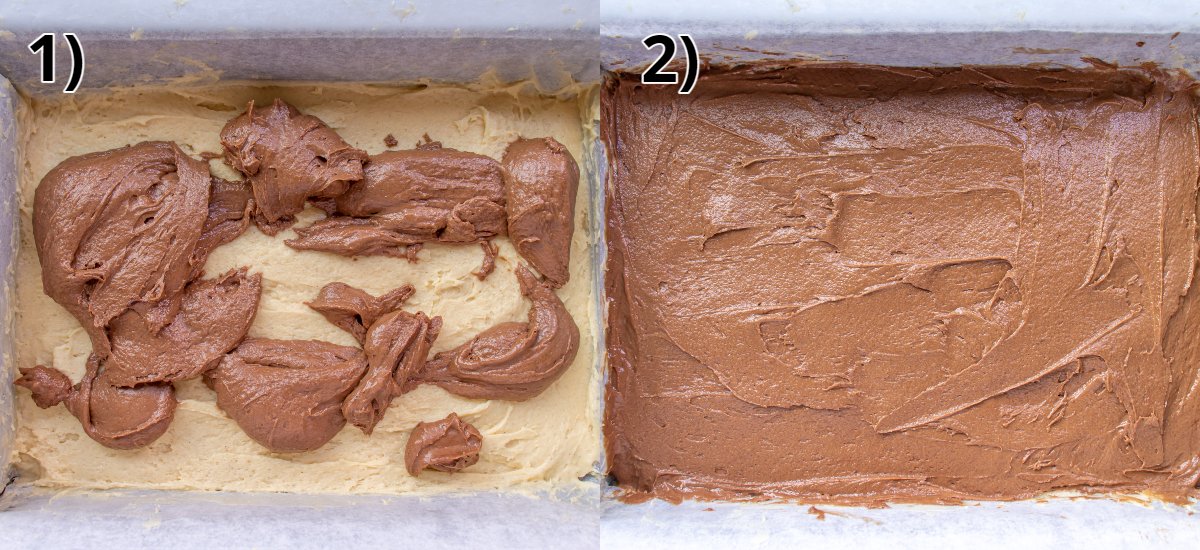
Evenly distribute the drained sour cherries over the batter.
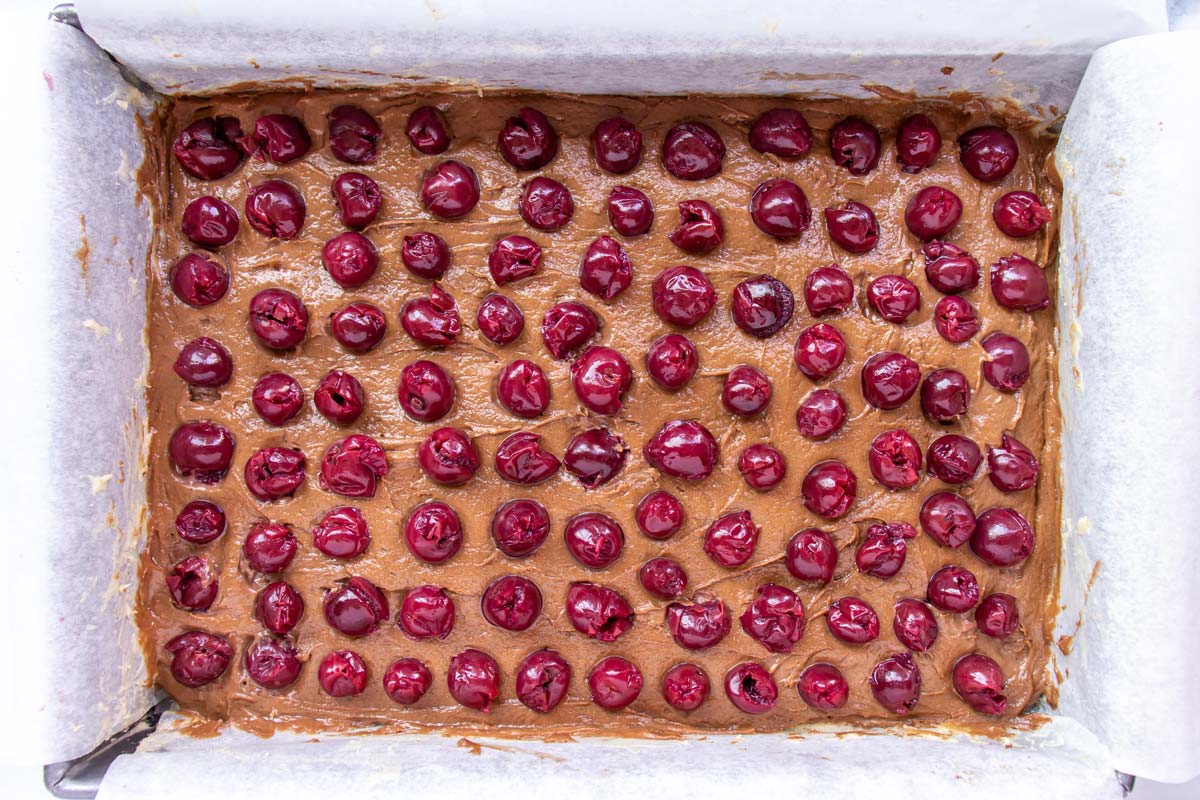
Bake until a toothpick inserted into the center comes out clean. Leave the Donauwelle cake in the pan but cool it completely before decorating, about 1 to 1 ½ hours.
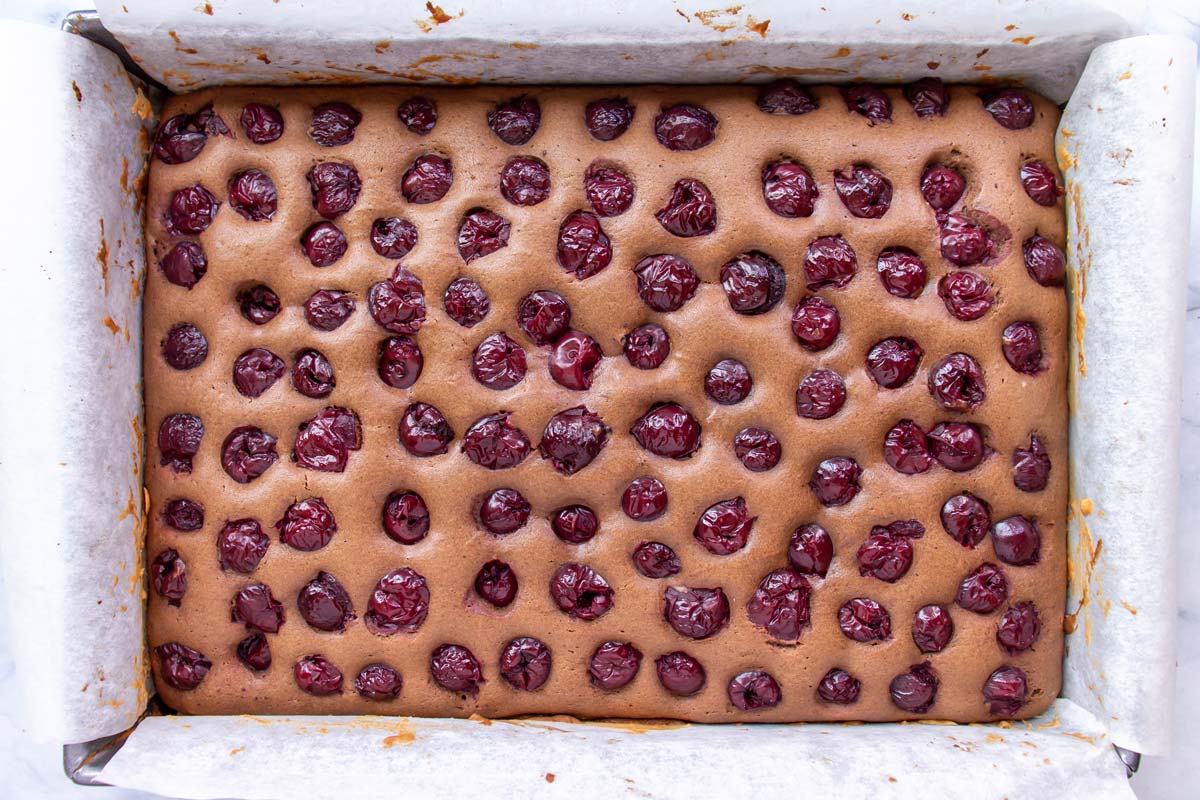
How to assemble and finish the cake
Spread the buttercream on top of the cooled Donauwelle cake, and cover with plastic wrap directly in contact with the buttercream. Chill the frosted cake for at least 1 hour or overnight.
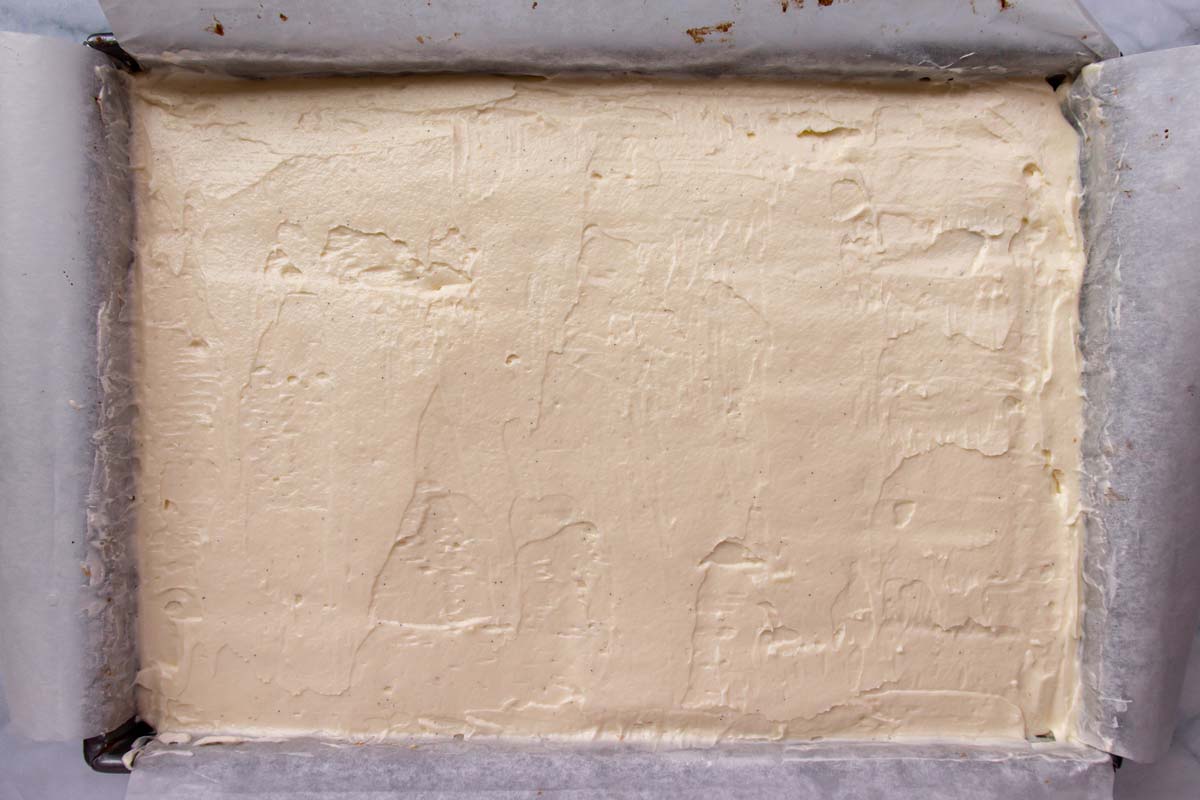
Next, make the chocolate ganache topping. Add chopped chocolate to a medium mixing bowl. Then heat the cream in a small saucepan over medium-high heat until steaming but not quite boiling. Pour the cream over the chocolate and let it sit for 2 minutes, then gently stir together until smooth.
Remove the plastic wrap from the Donauwelle cake and pour the ganache over the top.
Note: Instead of spreading ganache with a spatula, carefully tilt the Donauwelle cake from side to side as needed to ensure even coverage.
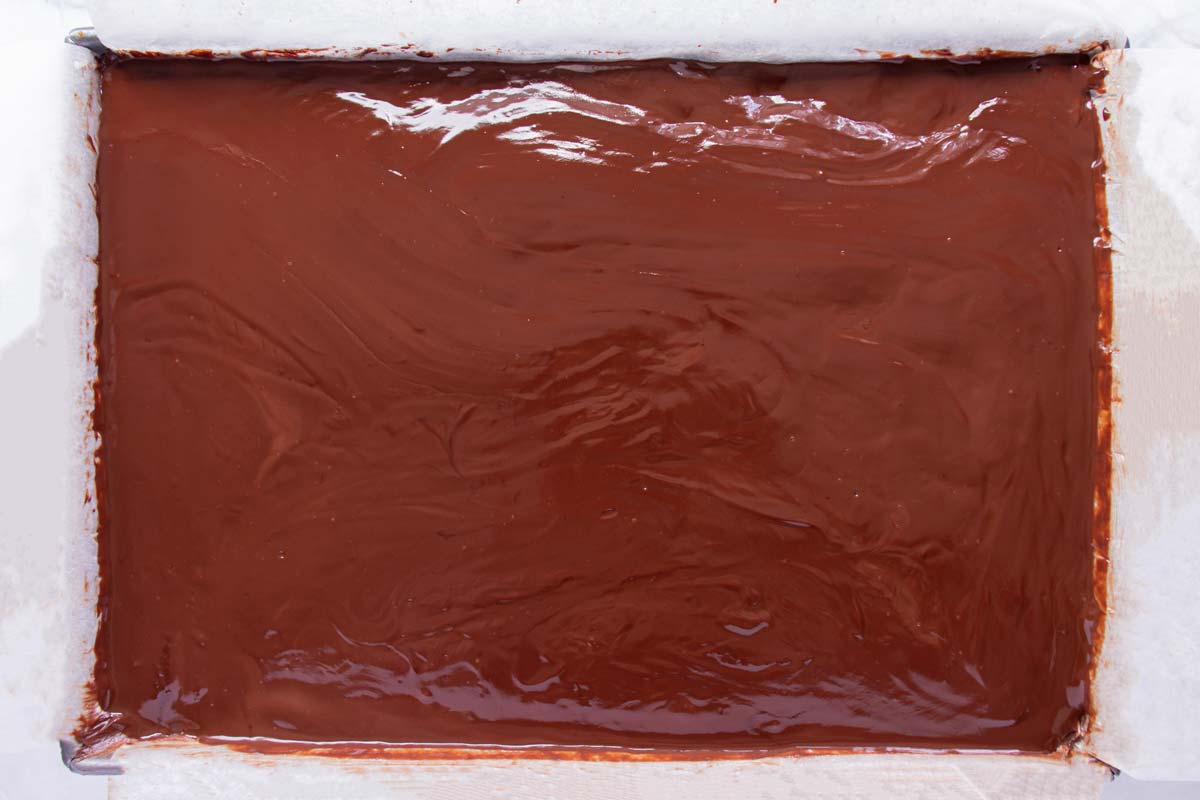
Allow it to cool for about 10 to 15 minutes at room temperature, and if the cake was already relatively cold it shouldn’t take long for the ganache to start to set.
Note: To test how much it has set, poke the ganache in one of the corners with the tip of a fork or knife to see if it leaves a clear impression. If it's still too soft, your waves will look messy.
Once it has set enough, if desired, use a fork or a pastry comb to lightly drag over the top and create a wavy pattern.
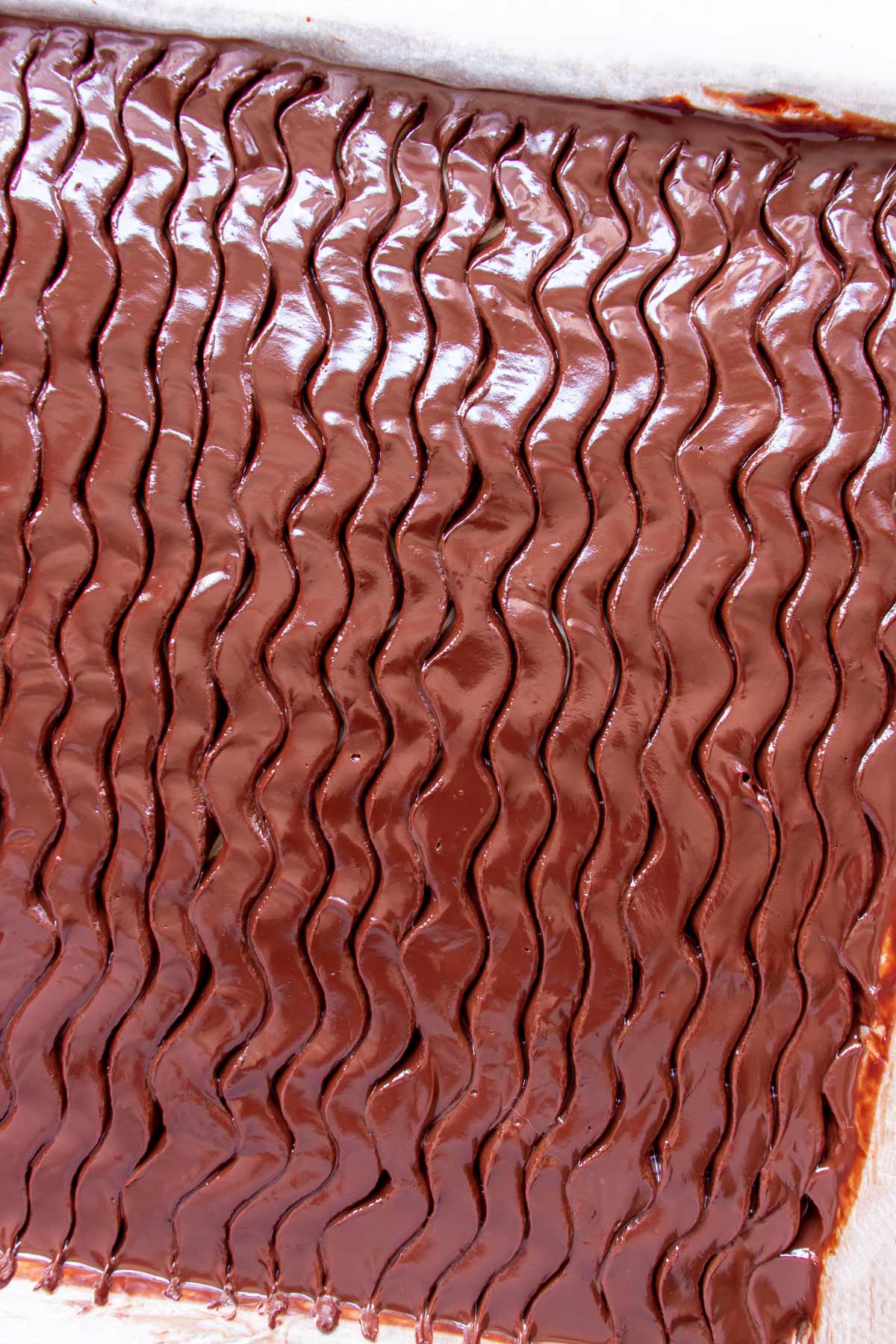
Cool the cake completely in the fridge for about 30 to 45 minutes to allow the ganache to fully set. At this point you may use the parchment paper overhang to carefully lift the cake out of the pan and set it on a large cutting board.
Peel down the 4 sides of parchment paper to expose the edges of the Danube wave cake. Cut into 15 rectangular slices (into thirds lengthwise and fifths crosswise). You may also cut Donauwelle cake into smaller pieces if you prefer.
Please scroll to the bottom of the post for the full recipe (in a printable recipe card) including ingredient amounts and detailed instructions.
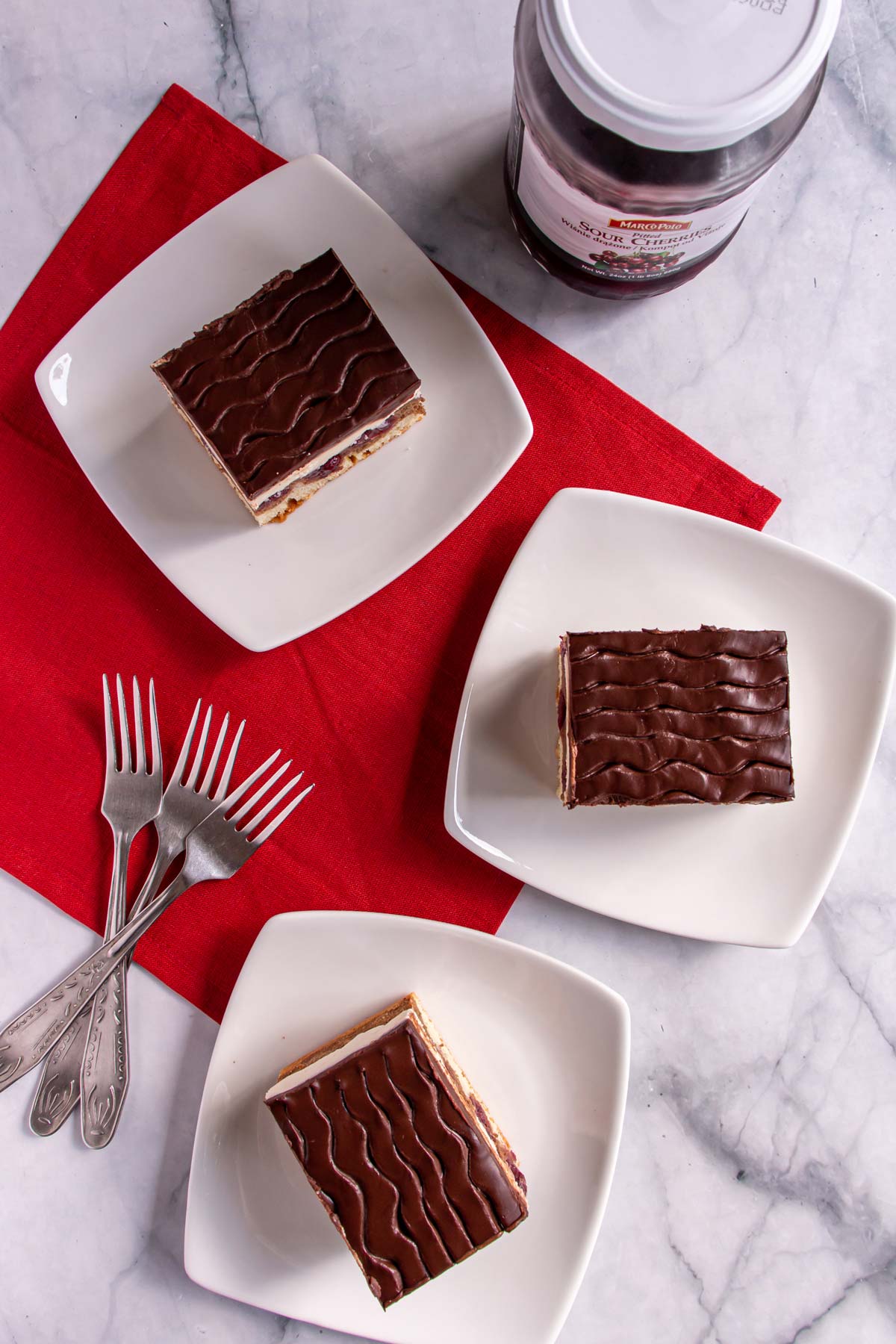
Expert tips
Refrigerate leftover Donauwelle cake slices for up to 3 days, but bring them back to room temperature before serving for the best texture. You can also freeze slices of Donauwellen, each individually wrapped in plastic wrap and then stored in a freezer bag, for up to 3 months. Thaw to room temperature before serving.
As with all baking, I highly recommend using the weight measurements instead of volume measurements if you have a kitchen scale. It is much more exact, but I have provided both measurement options for convenience.
Making Donauwelle cake is a bit time-consuming as it requires quite a few steps for 5 unique layers. I wouldn’t necessarily recommend this recipe to novice bakers, however the steps themselves are not challenging. They just require some time and patience.
It’s very important that the cake batter is thick and spreadable as opposed to loose and pourable. You absolutely need to maintain a relatively thick texture for the batter or else the cherries will sink rather than creating the distinctive Danube wave pattern that gives this cake its name.
To be honest, I think the most difficult step of making Danube wave cake is spreading the vanilla cake batter in the parchment paper lined cake pan because the parchment paper moves around. Use a finger to hold it down at each corner as you work your way around the pan to keep it in place. Some times of parchment paper may be more slippery than others. This can actually make it even harder to spread the batter. Once you are past that step, the rest should be smooth sailing (pun intended).
Use the flat side of a bowl scraper to help even out the buttercream layer in the pan. It’s ok if the baked cake is lumpy on top or the German buttercream is a little uneven. Adding the waves pattern into the ganache will cover up any imperfections in that layer as well. These variances add to the uniqueness of each individual slice.
Donauwelle is great for parties! Cut it into 24 to 30 smaller pieces which are still good-sized servings but better portions for entertaining large groups. You can cut each of the original slices in half, if you'd like.
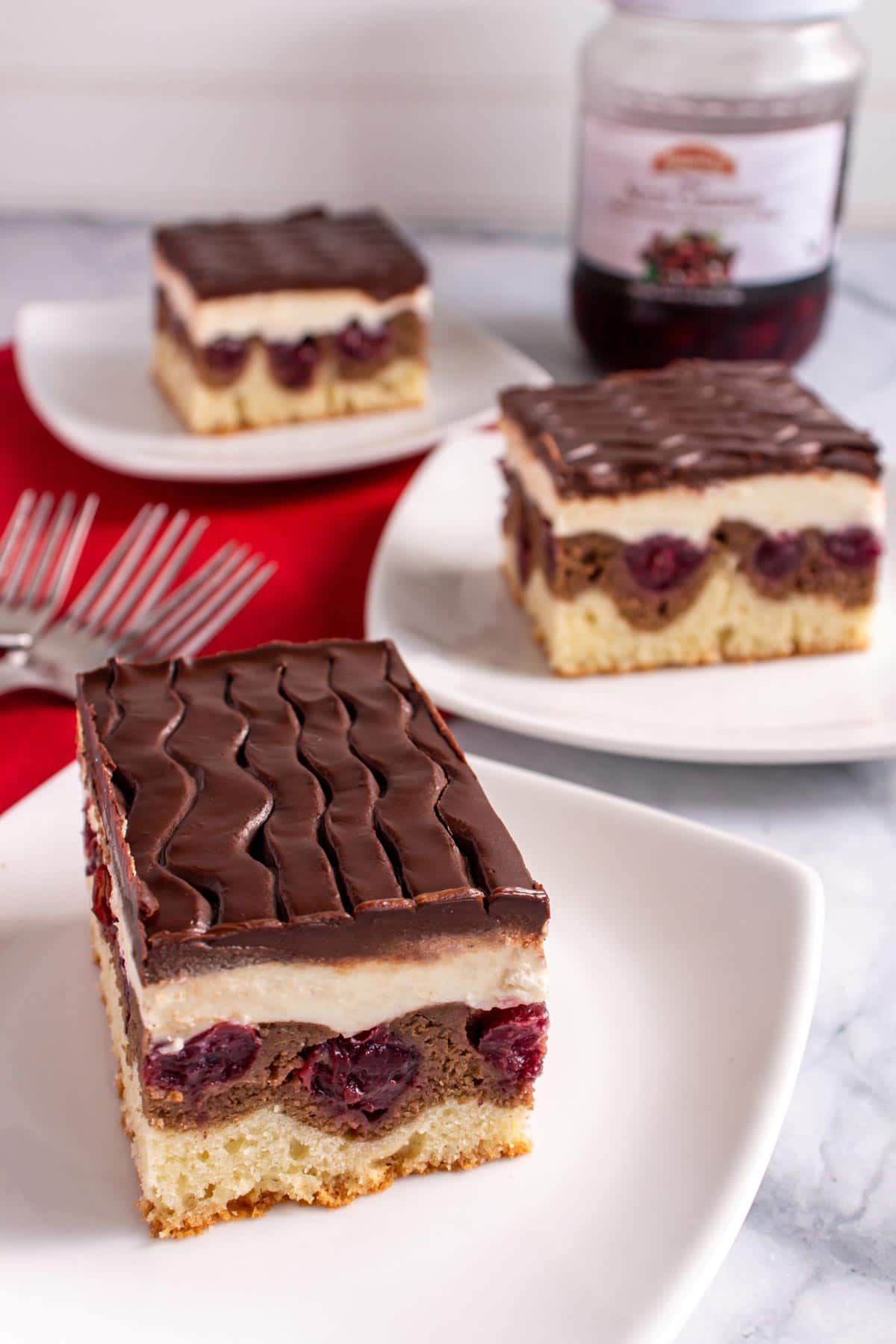
Other recipes you may like
- Zuger Kirschtorte (Swiss Cherry Torte)
- Rotweinkuchen (German Red Wine Cake)
- Kirschenmichel (German Bread Pudding with Cherries)
- Karpatka (Polish Carpathian Mountain Cake)
- Wuzetka (W-Z Polish Chocolate Cream Cake)
- Cremeschnitten (Austrian Cream Slices)
- Heidesand (German Brown Butter Shortbread Cookies)
- Zebra Cake with Chocolate Glaze
Tried this recipe? Please leave a star ⭐️⭐️⭐️⭐️⭐️ rating in the recipe card below and/or a review in the comments section further down the page. You can also follow me on social media on Facebook, Instagram, and Pinterest!
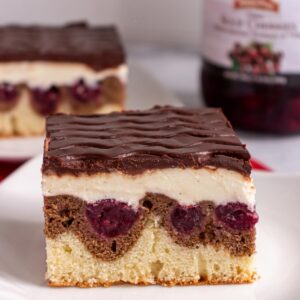
Donauwelle (Danube Wave Cake) / Schneewittchenkuchen (Snow White Cake)
Ingredients
German Buttercream:
- 2 egg yolks
- 2 cups milk
- ¼ cup (30 grams) cornstarch
- ½ cup (100 grams) granulated sugar
- 1 teaspoon vanilla paste or pure vanilla extract
- 8 ounces (225 grams) unsalted butter, room temperature
Cake:
- 3 cups (375 grams) all-purpose flour
- 1 tablespoon baking powder
- ¼ teaspoon kosher salt
- 8 ounces (225 grams) unsalted butter, room temperature
- 1 cup (200 grams) granulated sugar
- 5 large eggs, room temperature
- 1 teaspoon vanilla paste or pure vanilla extract
- ¼ cup (20 grams) cocoa powder
- ¼ cup milk
- 2 cups (about 300 grams) drained canned or jarred pitted sour cherries in water or light syrup (One 24-ounce/680 gram jar of sour cherries will yield this much once drained—use paper towels to soak up extra juices)
Chocolate Ganache:
- 8 ounces (225 grams) chopped bittersweet chocolate (70% cacao recommended)
- 1 cup (8 ounces) heavy cream
Instructions
- To start the German buttercream: In a large saucepan or small pot beat the egg yolks together, then slowly add the milk beating until smooth. Add the sugar and cornstarch and whisk until smooth.
- Heat the pan over medium heat, whisking constantly until the mixture is very thick and easily coats the back of a spoon and/or reaches a temperature of 180°F/80°C with an instant read thermometer, about 10 to 15 minutes total.
- Remove from the heat, whisk in vanilla until smooth, then use a rubber spatula to scrape the pastry cream mixture into a bowl. It will cool faster if it’s spread out in a wider bowl or container. Press a piece of plastic wrap directly onto the surface of the custard so it doesn't form a skin. Cool it to room temperature. (You can do this step up to 2 days in advance and refrigerate it until needed. In that case, bring it back to room temperature before using.)
- To make the cake: Preheat the oven to 350°F / 180°C with the rack in the lower third of the oven. Line a 9-by-13-inch (24-by-32-cm) rectangular cake pan with parchment paper with some overhang around the sides to help you lift the cake out of the pan after assembling. Lightly grease the parchment.
- Combine the flour, baking powder, and salt in a mixing bowl and set aside.
- Add the butter and sugar to the bowl of an electric mixer fitted with the paddle attachment and beat on medium speed until light and fluffy (about 2 to 3 minutes). Add the eggs, one at a time, beating between additions until smooth. Scrape down the sides and beat in the vanilla.
- Add the flour mixture in 2 additions and beat just until combined.
- Evenly spread about ⅔ of the cake batter into the prepared pan.
- Sift the cocoa powder into the remaining batter and add the milk. Mix until just combined, then carefully spread it over the top of the light-colored batter. The best way to do this is to dollop spoonfuls of chocolate batter over the vanilla layer and then carefully spread the batter until the chocolate layer is even. Do not swirl them together!
- Evenly distribute the drained sour cherries over the batter. Bake for 28 to 32 minutes or until a toothpick inserted into the center comes out clean. Leave the cake in the pan but cool it completely before decorating, about 1 to 1 ½ hours.
- To finish the German buttercream: The pastry cream and butter should both be at room temperature before proceeding with this next step. Add the butter to the bowl of an electric mixer fitted with the whisk attachment and beat until very light and creamy (about 2 minutes).
- With the mixer running on medium speed, add the pastry cream a little at a time until completely combined. Scrape down the sides and then continue beating for another minute to ensure it’s smooth and creamy.
- Spread the buttercream on top of the cooled cake, and cover with plastic wrap directly in contact with the buttercream. Chill the frosted cake for at least 1 hour or overnight.
- To make the chocolate ganache: Add the chopped chocolate to a medium mixing bowl. Then heat the cream in a small saucepan over medium-high heat until steaming but not quite boiling. Pour the cream over the chocolate and let it sit for 2 minutes, then gently stir together until smooth.
- To assemble the Donauwelle: Remove the plastic wrap from the cake and pour the ganache over the top. Instead of spreading it with a spatula, carefully tilt the cake from side to side as needed to ensure even coverage. Allow it to cool for about 10 to 15 minutes at room temperature, and if the cake was already relatively cold it shouldn’t take long for the ganache to start to thicken and set. (To test how much it has set, poke the ganache in one of the corners with the tip of a fork or knife to see if it leaves a clear impression. If it's still too soft, your waves will look messy.)
- Once it has set enough, if desired, use a fork or a pastry comb to lightly drag over the top and create a wavy pattern.
- Cool the cake completely in the fridge for about 30 to 45 minutes to allow the ganache to fully set.
- Use the parchment paper overhang to carefully lift the cake out of the pan and set it on a large cutting board. Peel down the 4 sides of parchment paper to expose the edges of the cake. Cut into 15 rectangular slices (into thirds lengthwise and fifths crosswise). You may also cut the cake into smaller pieces if you prefer.
- Refrigerate leftover cake slices for up to 3 days, but bring them back to room temperature before serving for the best texture.
Notes
- You can freeze slices of cake, each individually wrapped in plastic wrap and then stored in a freezer bag, for up to 3 months. Thaw to room temperature before serving.
- It’s very important that the cake batter is thick and spreadable as opposed to pourable. You absolutely need to maintain a relatively thick texture for the batter or else the cherries will sink rather than creating the distinctive wave pattern that gives this cake its name.
- The most difficult step in this recipe is spreading the vanilla cake batter in the parchment paper lined cake pan because the parchment paper moves around. Use a finger to hold it down at each corner as you work your way around the pan to keep it in place.
- After draining, check the jarred pitted cherries to ensure there aren't any pits left in them. Occasionally one or two slips through! You do not want to serve cake with cherry pits in it!
- Donauwelle is great for parties! Cut it into 24 to 30 smaller pieces (you can cut each of the original slices in half) which are still good-sized servings but better portions for entertaining large groups.
Nutrition
*All nutritional information is based on third-party calculations and should be considered estimates. Actual nutritional content will vary with brands used, measuring methods, portion sizes and more.*

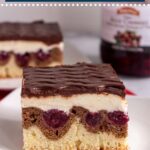
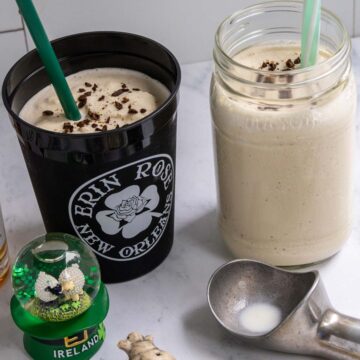
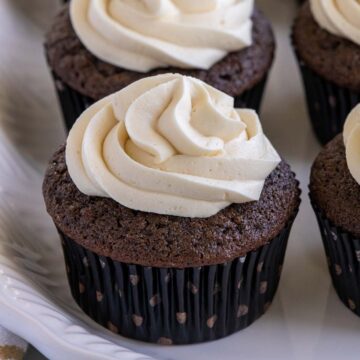


Dee says
This is a beautiful cake; made it for New Year’s Day. I made one change: I added approximately 3/4 to 1 cup of buttermilk to the cake batter to loosen it up a bit. It was still spreadable, not pourable, probably more moist, and still developed those lovely “waves”.
Lola says
This recipe is easy to follow, and the result is a delicious, light, buttery donauwelle. Perfect!
Terri says
So, yeah, spreading the batter is a pain, but, it is a pain worth bearing. Everyone, everyone loved this cake!! The butter cream is really light.